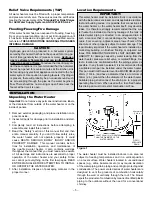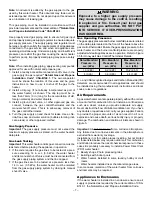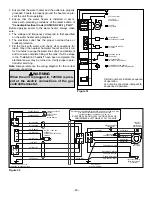
Filling the Water Heater
Do not insert the power cord into the electrical receptacle until
all the following steps have been completed.
Make sure the drain valve is closed.
Open a nearby hot-water faucet served by the system to
allow air to escape from the tank.
Open the cold-water inlet valve.
Note:
When filling, avoid water leakage. Do not allow
the insulation of the water heater to get wet as water
can reduce the effectiveness of the insulation.
When an uninterrupted stream of water, without apparent
air bubbles, flows from the open hot-water faucets, the
tank is full.
Close the hot-water faucets and check the system for
leaks. Repair as required and retest.
Please note the following:
The system should be installed only with piping that is suitable
for potable (drinkable) water.
DO NOT
use any pumps, valves, or
fi
ttings that are not
compatible with potable water.
AVOID
use of valves that may cause excessive restriction to
water
fl
ow. Use full
fl
ow ball or gate valves only.
DO NOT
use any lead based solder in potable water lines.
Use appropriate tin-antimony or other equivalent material.
DO NOT
tamper with the gas control/thermostat, igniter,
fl
ammable vapour sensor or temperature and pressure relief
valve. Tampering voids all warranties. Only a quali
fi
ed service
technician should service these components.
DO NOT
use with piping that has been treated with chromates,
boiler seal, or other chemicals.
DO NOT
add any chemicals to the system piping which will
contaminate the potable water supply.
COLD WATER
INLET
COLD WATER
INLET VALVE
TEMPERATURE AND
PRESSURE RELIEF VALVE
HOT
WATER
OUTLET
UNION
DRAIN PAN CONNECT TO
PROPERLY OPERATING
FLOOR DRAIN.
DISCHARGE LINE 300mm
(12 in.) max ABOVE FLOOR
In a closed system use either:
1.THERMAL EXPANSION TANK
2.PRESSURE RELIEF VALVE.
NOTE: BLOWER
ASSEMBLY NOT
SHOWN FOR
CLARITY.
1
2
Figure 27
1.
2.
3.
4.
5.
COLD WATER
INLET
HOT
WATER
OUTLET
TEMPERING
VALVE (SET
TO 49°C
(120°F))
FOLLOW THE
TEMPERING
VALVE
MANUFACTURER'S
INSTRUCTIONS
T&P VALVE
AND
DISCHARGE
LINE
COLD W
ATER
TEMPERED
WATER T
O
FIXTURE
Figure 28
Closed System/Thermal Expansion
Water supply systems may, because of code requirements
or such conditions as high line pressure, among others, have
installed devices such as pressure reducing valves, check
valves, and back
fl
ow preventers. Devices such as these
cause the water system to be a closed system. As water is
heated, it expands (thermal expansion). In a closed system
the volume of water will grow when it is heated. As the volume
of water grows there will be a corresponding increase in water
pressure due to thermal expansion. Thermal expansion can
cause premature tank failure (leakage). This type of failure is
not covered under the limited warranty. Thermal expansion
can also cause intermittent Temperature-Pressure Relief Valve
operation: water discharged from the valve due to excessive
pressure buildup. This condition is not covered under the
limited warranty. The Temperature-Pressure Relief Valve is
not intended for the constant relief of thermal expansion. A
properly sized thermal expansion tank must be installed on
all closed systems to control the harmful effects of thermal
expansion. Contact a local plumbing service agency to have
a thermal expansion tank installed.
Important:
Do not plug or remove the temperature and
pressure (T&P) relief valve.
Temperature and Pressure (T&P) Relief
Valve
For protection against excessive pressures and temperatures,
a temperature and pressure relief valve must be installed in
the opening marked "T&P RELIEF VALVE" (see Figure 30).
This valve must be design certi
fi
ed to meet the requirements
of the
"Standard For Relief Valves For Hot Water Supply
Systems", ANSI Z21.22/CSA 4.4
. The function of the
temperature and pressure relief valve is to discharge water
in large quantities in the event of excessive temperature or
pressure developing in the water heater. The valve's relief
pressure must not exceed the working pressure of the water
heater as stated on the data plate.
– 18 –
















































